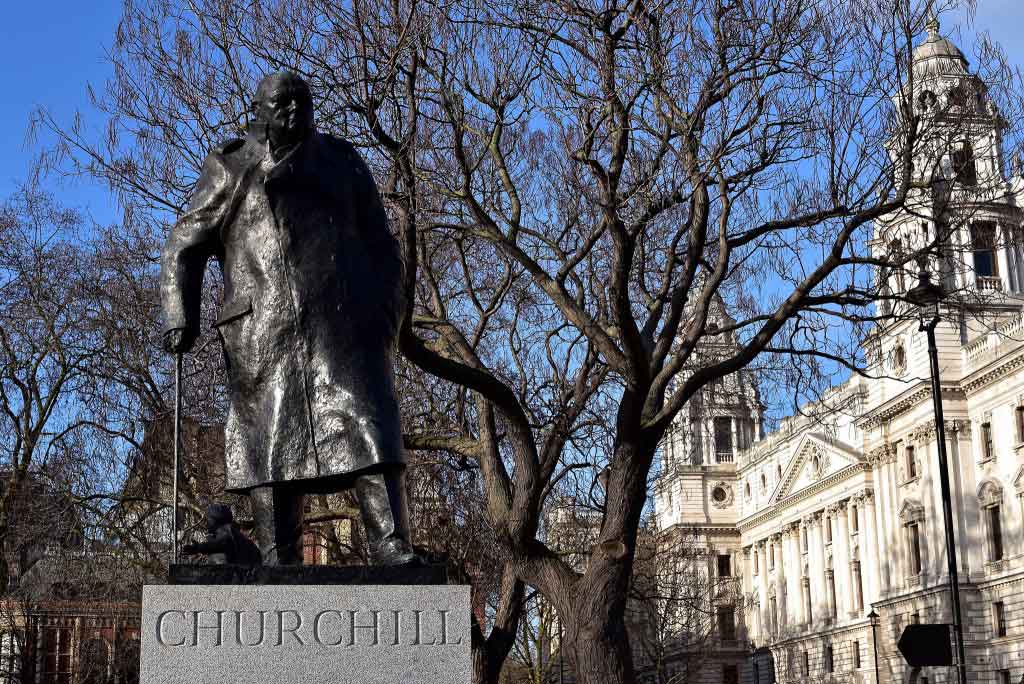
Finest Hour 135
No Churchill, None of the Time

Winston Churchill, Parliament Square, London © Sue Lowry & Magellan PR
June 29, 2013
Finest Hour 135, Summer 2007
Page 59
No Churchill, None of the Time
From Churchill’s War Rooms: Letters of a Secretary 1943-45, by Joanna Moody. Stroud, Glos. Tempus, 256 pages, hardbound $50, member price $40.

2025 International Churchill Conference
By David Hatter
Mr. Hatter, of Ongar, Essex, is a Chartwell guide, who wrote about the Chartwell Visitors Book in Finest Hour 131.
The disappointments begin with this book’s misleading and potentially deceptive title. The implication is that it’s about Churchill; or has some connection to him—or someone who at least dealt with him, who remembered witticisms we hadn’t heard before. Any connection would do, in fact, other than that the person merely worked in the Cabinet War Rooms.
Yes, they were “Churchill’s War Rooms,” but it’s difficult to recall their ever being so described. Apart from this rather tenuous connection, you are left wondering why Churchill’s name is in the title. It really is the publisher’s responsibility to ensure that a title reflects a book’s content. Churchill’s name is so valuable that in this case, the publisher used it to maximize appeal. Readers will be let down by the discrepancy between the title and the content.
The subject of the book is the delightful Olive Margerison, who appeared on a television news programme last December. She is 92 and looks and sounds 29: sharp, vivacious, altogether engaging. Her story is, however, not particularly remarkable. She worked for General Leslie Hollis1 (Secretary, Chiefs of Staff Committee). She went on some of the official wartime journeys with Hollis (and, ipso facto, Churchill). Then Olive Christopher, she was engaged to Neil Margerison, who was away serving with the forces.
The first part of the book deals with Olive’s life through 1943. It is an everyday story of wartime folk and, apart from what looks like a mix-up on page 47 over the dates when Dudley Pound2 and Andrew Cunningham3 served as First Sea Lords, it tells yet again an unexceptionable story about life in the Thirties and about the shortages of lavatories in the War Rooms.
The second part covers Olive’s correspondence with her fiancé and contains protestations of affection, which engender a feeling of sympathy for the separated sweethearts but are remarkably mundane otherwise. There are a few howlers, such as the reference to HMS Renown and HMS Penelope as “battleships.” All in all, it was a relief to reach the end. The book is fundamentally a personal record and, while it will evoke memories of the way things were during the Second World War, it really adds nothing to our knowledge of Churchill. The main body of readers will comprise enthusiasts who default to buying anything with the Great Man’s name in the title. I am left with the feeling that if I had really wanted to read another book about what life was like during the war, I could have written it myself.
Endnotes
1. General Sir Leslie Chasemore [Jo] Hollis KCB, KBE (1897–1963). Secretary, Chiefs of Staff Committee, travelled a with Ismay and Churchill, and is mentioned in WSC’s The Second World War; but the context is usually that of carrying out routine tasks. He is not mentioned in Gilbert’s Churchill: A Life, or in the Macmillan Dictionary of the Second World War.
2. Admiral of the Fleet Sir Alfred Dudley Pickman Rogers Pound RN (1877-1943). First Sea Lord, June 1939-September 1943.
3. Admiral of the Fleet Sir Andrew Browne Cunningham, First Viscount Cunningham of Hyndhope KT GCB OM DSO (1882-1963). Succeeded Pound as First Sea Lord. A member of the Chiefs of Staff Committee, Cunningham was responsible for strategic direction of the navy for the remainder of the war. He attended the conferences at Cairo, Teheran, Quebec, Yalta and Potsdam. Cunningham served as First Sea Lord until his retirement in 1946.
Subscribe
WANT MORE?
Get the Churchill Bulletin delivered to your inbox once a month.



